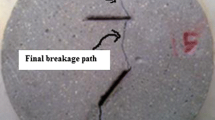The hollow Brazilian disc-type specimens of transversely bedded geo-materials were numerically modeled using the particle discrete element codes PFC2D for investigating the mechanical behavior and failure mechanism of the transversely isotropic rocks. The breakage mechanism and tensile strength of the transversely isotropic layered rocks were numerically studied using the hollow disc specimens. This numerical code was calibrated by the indirect tensile testing accomplished on the Brazilian disc specimens in the laboratory. Then, about 21 modeled hollow disc specimens with an outer diameter of 100 mm were considered. These specimens were established with two bedding layers in which the first one was the weakest layer with low mechanical characteristics and the second layer had relatively high mechanical parameters (close to those of the intact geo-material). In this study, the angle of the first (weak) layer relative to the applied loading direction varied. The angle of the second (stronger) layer was kept constant (i.e., 180° with respect to the loading direction). The numerical results showed that tensile cracks could develop in the weak layer, and their number decreased as the weak layer’s thickness increased. On the other hand, the strong layer experienced no failure during the loading process.








Similar content being viewed by others
References
G. Xu, C. He, and Z. Chen, “Mechanical behavior of transversely isotropic rocks with non-continuous planar fabrics under compression tests”, Comput. Geotech., 115, 103175 (2019).
R. H. Cao, R. Yao, T. Hu, et al., “Failure and mechanical behavior of transversely isotropic rock under compression-shear tests: Laboratory testing and numerical simulation”, Eng. Fract. Mech., 241, 107389 (2021).
L. Xia and Y. Zeng, “Parametric study of smooth joint parameters on the mechanical behavior of transversely isotropic rocks and research on calibration method”, Comput. Geotech., 98, 1–7 (2018).
B. Park, K. B. Min, N. Thompson, and P. Horsrud, “Three-dimensional bonded-particle discrete element modeling of mechanical behavior of transversely isotropic rock”, Int. J. Rock Mech. Min., 110, 120–132 (2018).
P. Tan, Y. Jin, and H. Pang, “Hydraulic fracture vertical propagation behavior in transversely isotropic layered shale formation with transition zone using XFEM-based CZM method,” Eng. Fract. Mech., 248, 107707 (2021).
P. Shen, H. Tang, B. Zhang, et al., “Investigation on the fracture and mechanical behaviors of simulated transversely isotropic rock made of two interbedded materials”, Eng. Geol., 286, 106058 (2021).
T. S. Yun, Y. J. Jeong, K. Y. Kim, and K. B. Min, “Evaluation of concrete anisotropy using 3D X-ray computed tomography,” Eng. Geol., 163, 11–19 (2013).
B. Lahmira, R. Lefebvre, M. Aubertin, and B. Bussiere, “Effect of heterogeneity and anisotropy related to the construction method on transfer processes in waste rock piles”, J. Contam. Hydrol., 184, 35–49 (2016).
Y. Sun, Y. Zhao, X. Wang, et al., “Synchrotron radiation facility-based quantitative evaluation of pore structure heterogeneity and anisotropy in coal”, Petrol. Explor. Dev., 46, No. 6, 1195–1205 (2019).
M. Sagong, D. Park, J. Yoo, and J. S. Lee, “Experimental and numerical analyses of an opening in a jointed concrete mass under biaxial compression”, Int. J. Concrete Mech. Min. Sci., 48, 1055–1067 (2011).
T. Li, M. Li, X. Jing, et al., “Influence mechanism of pore-scale anisotropy and pore distribution heterogeneity on permeability of porous media”, Petrol. Explor. Dev., 46, No. 3, 594–604 (2019).
Z. A. Moradian, G. Ballivy, P. Rivard, et al., “Evaluating damage during shear tests of concrete joints using acoustic emission”, Int. J. Concrete Mech. Min. Sci., 47, 590–598 (2010).
C. Cheng, X. Chen, and S. Zhang, “Multi-peak deformation behavior of jointed concrete mass under uniaxial compression: insight from particle flow modeling”, Eng. Geol., 213, 25–45 (2016).
A. Ghazvinian, R. G. Vaneghi, M. R. Hadei, and M. J. Azinfar, “Shear behavior of inherently anisotropic concretes”, Int. J. Concrete Mech. Min. Sci., 61, 96–110 (2013).
A. Lisjak, G. Grasselli, and T. Vietor, “Continuum-discontinuum analysis of failure mechanisms around unsupported circular excavations in anisotropic clay shales”, Int. J. Concrete Mech. Min. Sci., 65, 96–115 (2014).
M. Bahaaddini, G. Sharrock, and B. K. Hebblewhite, “Numerical direct shear tests to model the shear behaviour of concrete joints”, Comput. Geotech., 13, 101–115 (2013).
P. L. P. Wasantha, P. G. Ranjith, T. Xu, et al. “A new parameter to describe the persistency of non-persistent joints”, Eng. Geol., 181, 71–77 (2014).
W. Z. Chen, J. P. Yang, X. D. Zou, and C. H. Zhou, “Research on macromechanical parameters of fractured concrete masses”, Chin. J. Concrete Mech. Eng., 27, 1569–1575 (2008).
D. O. Potyondy and P. A. Cundall, “A bonded-particle model for concrete”, Int. J. Concrete Mech. Min. Sci., 41, 1329–1364 (2004).
R. X. Peng, W. L. Qiu, and M. Jiang, “Application of a micro-model for concrete to the simulation of crack propagation”, Theor. Appl. Fract. Mec., 116, 103081 (2021).
Z. Dai, H. Ren, X. Zhuang, and T. Rabczuk, “Dual-support smoothed particle hydrodynamics for elastic mechanics”, Int. J. Comput. Methods, 14, No. 4, 1750039 (2016), https://doi.org/10.1142/S0219876217500396.
H. Ren, X. Zhuang, Y. Cai, and T. Rabczuk, “Dual-horizon peridynamics”, Int. J. Numer. Meth. Eng., 108, 1451–1476 (2016).
Particle Flow Code in 2-Dimensions: Problem Solving with PFC2D, Version 3.1, Itasca Consulting Group, Inc., Minneapolis (2004).
Author information
Authors and Affiliations
Corresponding author
Additional information
Translated from Problemy Mitsnosti, No. 3, p. 112, May – June, 2022.
Rights and permissions
Springer Nature or its licensor holds exclusive rights to this article under a publishing agreement with the author(s) or other rightsholder(s); author self-archiving of the accepted manuscript version of this article is solely governed by the terms of such publishing agreement and applicable law.
About this article
Cite this article
Fu, J.W., Guo, M.D., Haeri, H. et al. A Discrete Element Analysis of the Indirect Tensile Failure in Hollow Brazilian Discs of Bedded Geo-Materials. Strength Mater 54, 462–472 (2022). https://doi.org/10.1007/s11223-022-00421-3
Received:
Published:
Issue Date:
DOI: https://doi.org/10.1007/s11223-022-00421-3



